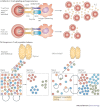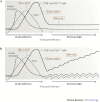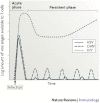Ageing and life-long maintenance of T-cell subsets in the face of latent persistent infections
- PMID: 18469829
- PMCID: PMC5573867
- DOI: 10.1038/nri2318
Ageing and life-long maintenance of T-cell subsets in the face of latent persistent infections
Abstract
A diverse and well-balanced repertoire of T cells is thought to be crucial for the efficacious defence against infection with new or re-emerging pathogens throughout life. In the last third of the mammalian lifespan, the maintenance of a balanced T-cell repertoire becomes highly challenging because of the changes in T-cell production and consumption. In this Review, I question whether latent persistent pathogens might be key factors that drive this imbalance and whether they determine the extent of age-associated immune deficiency.
Figures





Similar articles
-
Modelling naive T-cell homeostasis: consequences of heritable cellular lifespan during ageing.Immunol Cell Biol. 2009 Aug-Sep;87(6):445-56. doi: 10.1038/icb.2009.11. Epub 2009 Mar 17. Immunol Cell Biol. 2009. PMID: 19290017
-
The golden anniversary of the thymus.Nat Rev Immunol. 2011 May 27;11(7):489-95. doi: 10.1038/nri2993. Nat Rev Immunol. 2011. PMID: 21617694 Review.
-
T cell homeostasis in centenarians: from the thymus to the periphery.Curr Pharm Des. 2010;16(6):597-603. doi: 10.2174/138161210790883705. Curr Pharm Des. 2010. PMID: 20388069 Review.
-
Comment on "Cutting edge: human CD4-CD8- thymocytes express FOXP3 in the absence of a TCR".J Immunol. 2008 Jul 15;181(2):857-8; author reply 858. doi: 10.4049/jimmunol.181.2.857. J Immunol. 2008. PMID: 18606635 No abstract available.
-
Alterations in the Thymic Selection Threshold Skew the Self-Reactivity of the TCR Repertoire in Neonates.J Immunol. 2017 Aug 1;199(3):965-973. doi: 10.4049/jimmunol.1602137. Epub 2017 Jun 28. J Immunol. 2017. PMID: 28659353
Cited by
-
Chemotherapy combined with immune checkpoint inhibitors may overcome the detrimental effect of high neutrophil-to-lymphocyte ratio prior to treatment in esophageal cancer patients.Front Oncol. 2024 Oct 11;14:1449941. doi: 10.3389/fonc.2024.1449941. eCollection 2024. Front Oncol. 2024. PMID: 39464714 Free PMC article.
-
Age-related epithelial defects limit thymic function and regeneration.Nat Immunol. 2024 Sep;25(9):1593-1606. doi: 10.1038/s41590-024-01915-9. Epub 2024 Aug 7. Nat Immunol. 2024. PMID: 39112630 Free PMC article.
-
In vivo efficacy of phage cocktails against carbapenem resistance Acinetobacter baumannii in the rat pneumonia model.J Virol. 2024 Jul 23;98(7):e0046724. doi: 10.1128/jvi.00467-24. Epub 2024 Jun 12. J Virol. 2024. PMID: 38864621
-
The aged tumor microenvironment limits T cell control of cancer.Nat Immunol. 2024 Jun;25(6):1033-1045. doi: 10.1038/s41590-024-01828-7. Epub 2024 May 14. Nat Immunol. 2024. PMID: 38745085 Free PMC article.
-
Anti-cytomegalovirus antibody levels stratify human immune profiles across the lifespan.Geroscience. 2024 Oct;46(5):4225-4242. doi: 10.1007/s11357-024-01124-0. Epub 2024 Mar 21. Geroscience. 2024. PMID: 38512581 Free PMC article.
References
-
- Brody JA, Brock DB. Handbook of the Biology of Aging. 1985. Epidemiologic and statistical characteristics of the United States elderly population; pp. 3–42.
Publication types
MeSH terms
Substances
Grants and funding
LinkOut - more resources
Full Text Sources
Other Literature Sources
Medical

